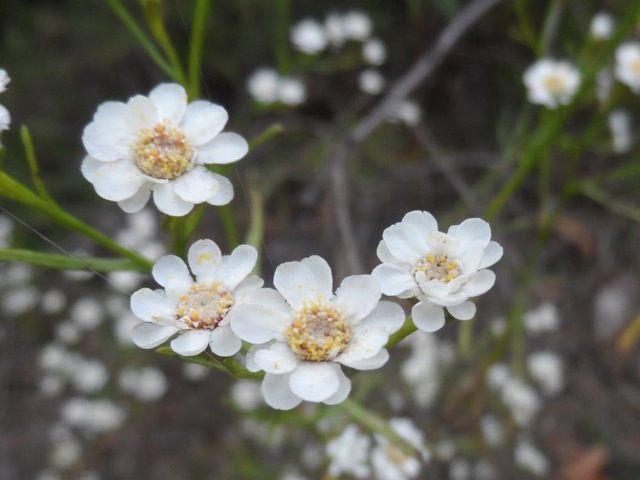In February, Ixodia Track can display the typical dry heathland, but there are still many worthwhile features to observe.
Firstly there are many grasses and sedges which form a significant portion of the bushland, and these include Austodonthonia species – the Wallaby Grasses of which there are many. Numerous sedges are included also e.g. Schoenus breviculinis – Matted Bog Sedge, which is a ground hugging species, with a soft feel. Along black Wattle Track, near a small dam, there is Gahnia radula – Thatch Saw-Sedge, and Juncus pallidus – Tall Rushes.
Along both tracks Heteronympha merope merope – Common Brown Butterfly was seen. It’s possible that these were females, as they are larger than the male, and are seen towards the end of summer. They are widely distributed throughout Australia. The females drop their eggs among long grass, often close to tree trunks. Also seen on Ixodia Track was a damaged specimen of the family Agaristidae (Day Moths).

Day Moth
These are medium sized moths, with clubbed antennae. They are usually brightly coloured, black and orange dominating (and can have cream bands and markings). They fly rapidly during the day and often feed on flowers. In high temperatures they may be found resting on tree trunks in shade.
On reaching Black Wattle Track the added moisture as run-off from the Great Ocean Road contributes valuably to the flora which is generally stronger and coping well during these dry periods. The beautiful Banksia marginata – Silver Banksia was seen with a number of flowers cones of different ages and colours.

Silver Banksia
The dark green foliage on the upper surface is a great foil for the greenish pale yellow and russet cones. The under surface of the leaves is pale, hence the name ‘Silver’ Banksia.
Further down the track were seen lovely specimens of Ixodia archillaeoides subsp. alata – Ixodia.

They flower late in summer in clusters at the end of the flower stems. They are made up of snowy white papery bracts and a centre (in young flowers which are creamy-yellow tubular florets) which is brownish as the flower ages. They have bright green narrow leaves about 8 cm long, which alternate along the stem.
Further along the track a specimen of Eucalyptus literalis – Anglesea Grey-gum was seen. There were still a few fresh flowers of a creamy colour, one with the cap still intact.

Anglesea Grey-gum
The flower heads usually have 7 buds, and are attached to a broadly flattened strap-like strongly ribbed stalk (peduncle) up to 2.5 cm long. The long tapering leaves can be 18-35 cm. In 2005 the Anglesea Grey-gum was recognised as a species in its own right.
Lastly, two examples of parasitic plants, which are found in the heathland/woodland are the dodder-laurels.
They are perennial herbs that twine and smother small shrubs and trees. At maturity they become rootless and attach to the host plant with sucker-like pads. Through penetrating of the host’s tissues the dodder obtains some of its nutritional requirements, and also makes some of its own food like other plants. The leaves are small scale-like; the flowers are also small. The fruits are berry-like and are attractive to birds, thus aiding the spread of the dodders throughout the bush.
Cassytha glabella forma dispar – Slender Dodder-laurel has smooth white flowers.

Cassytha melantha – Course Dodder-laurel is a strong rapidly growing parasite which can eventually impair or even kill its host plant. The globular fruit is smooth and pale green, which blackens as the fruit ages.

Course Dodder-laurel
When walking these tracks enjoy the great diversity of this very special district, Happy rambling.
Photographer: Neil Tucker
Reporter: P.Hesterman